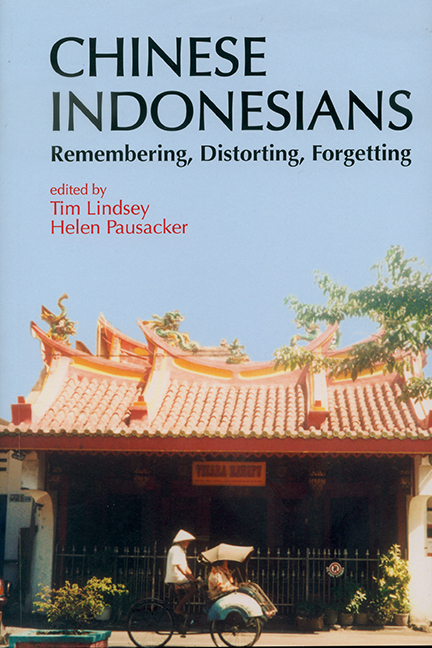Book contents
- Frontmatter
- Contents
- Preface
- A Brief Biography
- Contributors
- Glossary
- Introduction: Researching the Margins
- Bibliography of Charles Coppel's Work
- 1 Anti-Chinese Violence and Transitions in Indonesia: June 1998–October 1999
- 2 Reconstituting the Ethnic Chinese in Post-Soeharto Indonesia: Law, Racial Discrimination, and Reform
- 3 Buddhism and Confucianism in Contemporary Indonesia: Recent Developments
- 4 Portrait of the Chinese in Post-Soeharto Indonesia
- 5 The Makam Juang Mandor Monument: Remembering and Distorting the History of the Chinese of West Kalimantan
- 6 Confucianists and Revolutionaries in Surabaya (c1880–c1906)
- 7 The Chinese and the Early Centuries of Conversion to Islam in Indonesia
- 8 The Agony of Love: A Study of Peranakan Chinese Courtship and Marriage
- 9 Peranakan Chinese and Wayang in Java
- Index
5 - The Makam Juang Mandor Monument: Remembering and Distorting the History of the Chinese of West Kalimantan
Published online by Cambridge University Press: 21 October 2015
- Frontmatter
- Contents
- Preface
- A Brief Biography
- Contributors
- Glossary
- Introduction: Researching the Margins
- Bibliography of Charles Coppel's Work
- 1 Anti-Chinese Violence and Transitions in Indonesia: June 1998–October 1999
- 2 Reconstituting the Ethnic Chinese in Post-Soeharto Indonesia: Law, Racial Discrimination, and Reform
- 3 Buddhism and Confucianism in Contemporary Indonesia: Recent Developments
- 4 Portrait of the Chinese in Post-Soeharto Indonesia
- 5 The Makam Juang Mandor Monument: Remembering and Distorting the History of the Chinese of West Kalimantan
- 6 Confucianists and Revolutionaries in Surabaya (c1880–c1906)
- 7 The Chinese and the Early Centuries of Conversion to Islam in Indonesia
- 8 The Agony of Love: A Study of Peranakan Chinese Courtship and Marriage
- 9 Peranakan Chinese and Wayang in Java
- Index
Summary
INTRODUCTION
Speaking of the reception of Chinese–Malay literature in Indonesia, Charles Coppel wrote that local histories tend to “remember”, “distort”, and also “forget” the contribution of this body of writings (Coppel 2002, p. 191). In West Kalimantan local histories also tend to remember, distort, or forget the past of the relatively important Chinese minority and their contribution to local affairs. This is true in spite of their numbers — well over 10 per cent of the total population — and their significant economic position, as well as the determined opposition of Chinese gold miners to the expansion of Dutch rule in the nineteenth century (Heidhues 2003).
This chapter will look at the province's most striking historical monument and at some local versions of its history. The Makam Juang, burial place of those who struggle, or “Mandor Struggle Cemetery”, is situated near the town of Mandor, which is 88 kilometres northeast of Pontianak. Mandor itself was once a Chinese gold-mining town, home to the legendary Lanfang Kongsi, founded by Lo Fong Pak (Luo Fangbo) in 1777, and the longest-surviving of the gold miners' co-operative organizations that ruled much of northwestern Borneo in the eighteenth and nineteenth centuries. The Dutch Sinologist de Groot located a written history of Lanfang that had been composed in the nineteenth century, using it as the basis for his well-known work on Chinese kongsi (Groot 1885). Lanfang fell on bad times after the 1850s and the Dutch finally dissolved it in 1884.
- Type
- Chapter
- Information
- Chinese IndonesiansRemembering, Distorting, Forgetting, pp. 105 - 129Publisher: ISEAS–Yusof Ishak InstitutePrint publication year: 2005



